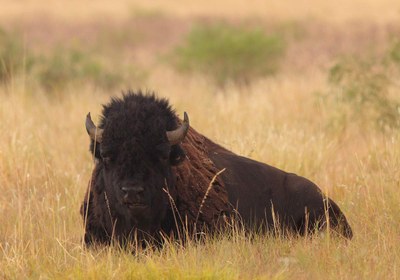The Story of the Bison
The cornerstone of the prairie
 Bison are a keystone species within the prairie ecosystem; this means they are an essential part of the prairie.
Bison are a keystone species within the prairie ecosystem; this means they are an essential part of the prairie.
Bison grazing allows plants to flourish, reduces the amount of dead vegetation, and encourages new growth, all of which influence the variety of plants and animals of the prairie. Their role in this ecosystem is as important as prairie fire.
Even the wallowing behavior of bison creates a unique mini-wetland environment while their waste provides needed fertilizer, all benefiting the prairie ecosystem.
Historically, bison were a valuable food source for predators, scavengers and humans. They provided everything needed for human survival on the plains including food, shelter, clothing and tools.
Bison in Texas
At one time, 30 to 60 million bison roamed the North American plains. Early Spanish explorers in Texas, including the Coronado expedition, said they were as numerous as “fish in the sea.”
The vast herds weren’t in danger of extermination until professional hide hunters arrived on the plains. With their superior weaponry, they could kill over 100 bison at a time.
Thus began the “great slaughter.” From 1874 to 1878, hunters decimated the great southern bison herd. Estimates from 1888 were that less than 1,000 head of bison remained in North America.
Preservation of an American icon
Towards the end of the great slaughter, a handful of people worried about the fate of the bison and began the difficult task of saving them. These people took on the care of orphaned calves and started their own herds.
Mary Ann Goodnight urged her husband Charles to capture some orphan calves from the southern herd in 1878. The Goodnights raised the bison calves on the JA Ranch as the nucleus of the Goodnight Herd, which soon grew to over 200 head.
The descendants of these animals now constitute the Texas State Bison Herd. The Goodnight Herd and four other herds provided the foundation stock for virtually all bison in North America today.
The Texas State Bison Herd
Following the death of the Goodnights, the herd faded from public awareness until wildlife conservationist Wolfgang Frey learned about the remaining 50 or so bison on the JA Ranch. He contacted the state of Texas in 1994.
Genetic testing by the Texas Parks and Wildlife Department discovered a rare genetic marker revealing that the herd was perhaps the last remaining group of southern plains bison.
The JA Ranch donated the herd to Texas Parks and Wildlife. The state moved the herd to Caprock Canyons State Park in 1997. Unique not only in its historical importance but also in its rare genetic makeup, the herd is now the Official Bison Herd of the state of Texas.
The herd remains in a portion of its natural home range on what was once a part of the JA Ranch and is now Caprock Canyons State Park.
Modern day management
The Texas State Bison Herd is a valuable resource for Texas and for the conservation of the bison species. Caprock Canyons State Park has three conservation objectives for the bison herd:
- Re-establishing them as a keystone species within the ecosystem
- Ensuring the genetic integrity of the herd through a selective breeding program
- Contributing to the overall conservation of the species of bison in North America.
Every winter, TPWD conducts DNA testing to closely monitor the herd’s genetic diversity. Each member of the herd also gets a health check.
Vegetation studies, grazing control and prescribed fire are all part of managing the herd’s habitat.
We carefully monitor this herd to help ensure an even brighter future for bison in North America.
